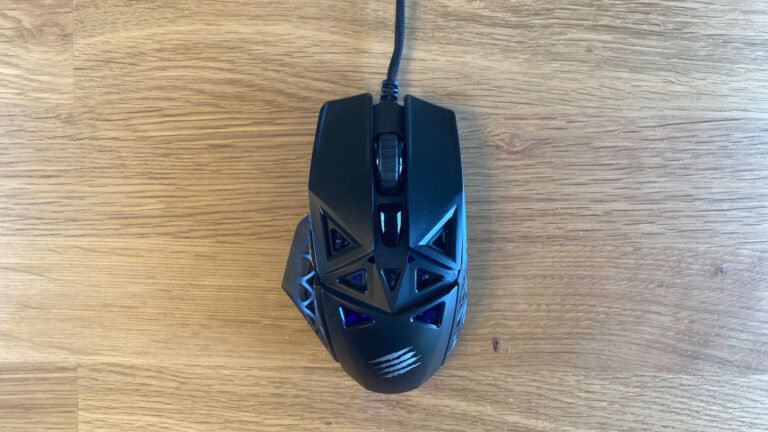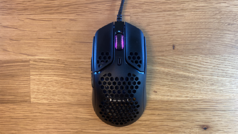
[ad_1]
Mad Catz’ newest mouse, the $49.99 M.O.J.O. M1, is an esports mouse that shakes up the familiar formula. Its has a surprisingly powerful sensor, a “honeycomb” design that’s actually a fractal pattern, and a thumb wing, an extra plastic piece that few esports mouse designers tolerate. Unfortunately, the M1 lacks configuration software, which makes it significantly less customizable than other gaming mice. Zigging and zagging, bucking small conventions at every turn, the Mojo M1 winds up coalescing into a cohesive package, so long as you aren’t particular about customizing your settings.

Got My Mojo Workin’
The M.O.J.O. M1 doesn’t follow the esports playbook to the letter. At 1.69 by 3.06 by 4.63 inches (HWD), it has the full-bodied width and length of a traditional gaming mouse. (Many ultralight esports mice are smaller and disproportionately short to minimize weight). The shape is fairly supportive, guiding your hand into a comfortable, but slippery, grip. It also has a thumb wing—rare commodity for an esports mouse, given the general emphasis on reducing weight. It resembles an ergonomic, “FPS” mouse like the award-winning Razer Basilisk more than a hole-riddled ultralight like the Glorious Model D.
Still, the M.O.J.O. M1 has many of the key characteristics found in high-performing esports mice. Weighing in at 2.36 ounces, it falls into that ultralight weight class that separates competitive esports mice from the imitators. Presumably, the mouse’s “honeycomb” chassis design, which minimizes mass by cutting holes in the mouse’s shell, plays a part in getting the weight down. In addition to dropping some grams, Mad Catz went the extra mile by creating a unique, stylish pattern with two layers of triangular holes, rather than the usual hexes.

It’s also a simple mouse. The M.O.J.O. M1 has a basic, six-button in the standard configuration: two click panels, a clickable scroll wheel, and a central button to switch DPI settings. Two buttons, back and forward, are housed on the thumb side. Every mouse manufacturer’s leaning on esports, but there’s little difference between a “basic” gaming mouse and one made for competition. Mostly, it comes down to the vibe and weight.
Similar Products
Where’s the Software?
That commitment to simplicity winds up being a liability, though. Unlike most gaming mice, including the excellent HyperX Pulsefire Haste, the M.O.J.O. M1 doesn’t have configuration software, so your ability to fine-tune the mouse’s performance is almost non-existent. You can cycle among four tracking settings ranging from 800 to 12,000 DPI using the central button, and choose from a few RGB light settings using a hotkey.

It’s a restrictive set of options, especially for a “performance-driven” mouse with a powerful sensor. The mouse’s Pixart PMW3360 sensor, which can track far more than four speeds, is surprisingly limited due to the lack of configuration software. Without that configuration software, you can’t enjoy app-specific customizations, which prove useful when playing PC games. You may malign the hassle of downloading and using an app, but it’s a necessary feature if you want a mouse that feels just right.
The lack of software also severely limits RGB customization. You can’t adjust the colors in any way beyond choosing from static red, a slow “Breathing” color cycle, and a faster “Spectrum” color cycle. The lighting feels like less of a loss than the more practical configuration features, because the lighting is underwhelming. The single RGB light glows softly from within the chassis, but isn’t powerful to light up the whole mouse interior. Rather than getting a clear, colorful look at the mouse’s exposed interior design, you get a small pop of light less powerful than what you’d in most sealed palm RGB elements, and a bit of underglow.

It’s Good Enough
The Mad Catz M.O.J.O. M1 has many strong qualities. It’s light. It has a fun, original design. It has a decent, if not always ergonomically sound shape. Plus, it’s hard to resist a mouse with a thumb wing. At $49.99, the M1 is a satisfactory pick if you care about weight and comfort, but don’t want to fiddle with settings.
At the same time, a gaming mouse without configuration software prevents pros and aspiring pros from enjoying nuanced performance, so its utility is limited. Instead, you should check out the similarly priced HyperX Pulsefire Haste, a recent Editors’ Choice pick for esports mice that lets you customize settings via its NGenuity app.
[ad_2]
Source link : https://www.pcmag.com/reviews/mad-catz-mojo-m1-gaming-mouse





